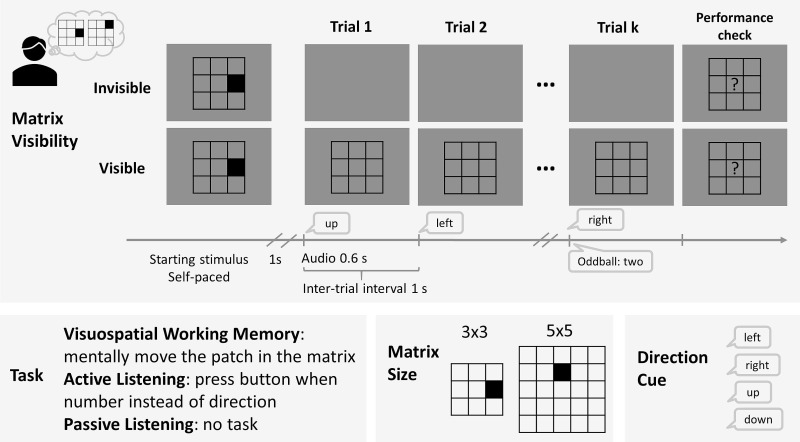CASE STUDY: Latent Geometrical Structures Behind Phasic Changes in Pupil Size

The primary function of the eyes is to focus on visual information, but our eyes are also active during the recollection of memories or engagement in visual mental imagery. In their recent research paper “How workload and availability of spatial reference shape eye movement coupling in visuospatial working memory“, Walcher, Korda, Körner, and Benedek (2024) provide significant insights into the intricate relationship between internal cognition and eye movements. The study, published in Cognition, highlights the invaluable contribution of eye-tracking technology in dissecting and understanding complex cognitive processes, particularly in the realm of visuospatial working memory (VSWM).
Eye Tracking and Visuospatial Working Memory Methodology
The experimental design was ingenious, employing a VSWM task where participants mentally moved a black patch along a path within a matrix, following audio instructions (“up”, “left”, etc.). Critically, the matrix’s visibility (visible vs. invisible) was manipulated, along with its size (3×3 vs. 5×5), to vary spatial reference availability and workload. Control conditions involving passive and active listening to the directional cues were also included.

Throughout the task gaze was recorded with an SR Research EyeLink 1000 Plus eye tracker, which allowed the researchers to measure the subtle, yet consistent, eye movements that mirrored the participants’ internal mental operations. The eye tracker allowed for the capture of crucial metrics such as saccade direction, latency, amplitude, and variation in amplitude. These precise measurements were fundamental in establishing that eye movements consistently matched the imagined movement of the patch, even when the matrix was invisible, thereby demonstrating the direct link between internal attention shifts and overt eye behavior.
Eye Tracking Shows Interplay Between Thought and Behavior
- Confirmation of Internal Coupling: The study found a strong internal coupling in the VSWM task, evidenced by saccade direction aligning with the imagined movement direction. This was significantly more pronounced than in listening-only conditions, demonstrating that eye movements were not merely triggered by auditory or semantic cues but by active mental processing.
- Importance of Spatial Reference: Eye-tracking data revealed that the availability of a visible spatial reference (the empty matrix) significantly enhanced the frequency and precision of coupled saccades, making them faster and less variable. This crucial insight underscores how external scaffolds can impact internal cognitive processes and their outward manifestations.
The ability to distinguish coupled saccades from other eye movements and to analyze their characteristics in detail was made possible by the exceptional levels of accuracy and precision delivered by the EyeLink 1000 Plus eye tracker. This research exemplifies how eye tracking can enhance our understanding of the dynamic interplay between internal thought and observable behavior, thereby advancing our understanding of fundamental cognitive mechanisms.
For information regarding how eye tracking can help your research, check out our solutions and product pages or contact us. We are happy to help!
